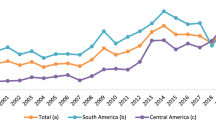Abstract
We compute public sector performance (PSP) and public sector efficiency (PSE) indicators, comprising a composite and seven sub-indicators, for 23 industrialised countries. The first four sub-indicators are “opportunity” indicators that take into account administrative, education and health outcomes and the quality of public infrastructure and that support the rule of law and a level playing-field in a market economy. Three other indicators reflect the standard “Musgravian” tasks for government: allocation, distribution and stabilisation. The input and output efficiency of public sectors across countries is then measured via a non-parametric production frontier technique. The study finds significant differences in PSP and PSE, which suggests a large potential for expenditure savings in many countries.
Similar content being viewed by others
References
Afonso, A., & Aubyn, St. M. (2003). Non-parametric approaches to education and health expenditure efficiency in the OECD (Mimeo), ISEG/UTL-Technical University of Lisbon.
Aubyn, St. M. (2002). Evaluating efficiency in the Portuguese health and education sectors (Mimeo) presented at the conference on Desenvolvimento Económico Português no Espaço Europeu: Determinantes e Políticas organised by Bank of Portugal, 24–25 May 2002.
Bouthevillain, C., Cour-Thimann, P., Van Den Dool, G., Hernandez de Cos, P., Langenus, G., Mohr, M., et al. (2001). Cyclically adjusted budget balances: An alternative approach (ECB Working Paper 77)
Brennan, G. (2000). The political economy of regulation (Mimeo), Australian National University.
Charnes, A., Cooper, W., & Rhodes, E. (1978). Measuring the efficiency of decision making units. European Journal of Operational Research, 2(6), 429–444.
Clements, B. (2002). How efficient is education spending in Europe? European Review of Economics and Finance, 1(1), 3–26.
Deprins, D., Simar, L., & Tulkens, H. (1984). Measuring labor-efficiency in post offices. In M. Marchand, P. Pestieau, & H. Tulkens (Eds.), The performance of public enterprises: Concepts and measurement. Amsterdam: North-Holland.
Fakin, B., & de Crombrugghe, A. (1997). Fiscal adjustment in transition economies: Social transfers and the efficiency of public spending: A comparison with OECD countries (Policy Research Working Paper 1803). Washington, DC: World Bank.
Gupta, S., & Verhoeven, M. (2001). The efficiency of government expenditure experiences from Africa. Journal of Policy Modelling, 23, 433–467.
Gwartney, J., Lawson, R., Park, W., Wagh, S., Edwards, C., & de Rugy, V. Vancouver, the Fraser Institute.
Mueller, D. (Ed.). (1997). Perspectives on public choice: A handbook. Cambridge: Cambridge University Press.
Persson, T., & Tabellini, G. (2001). Political institutions and policy outcomes: What are the stylized facts? (Mimeo)
Rodrik, D. (2000). Institutions for high-quality growth: What they are and how to Acquire them (NBER Working Paper 7540)
Schneider, F. (2002). The size and development of the shadow economies and shadow labor force of 22 transition and 21 OECD countries: What do we really know? (Mimeo), prepared for the Round Table Conference: On the Informal Economy, Sofia, Bulgaria, April 2002.
Shleifer, A., & Vishny, R. (1998). The grabbing hand: Government pathologies and their cures. Cambridge: Harvard University Press.
Simar, L., & Wilson, P. (2003). Efficiency analysis: The statistical approach (Lecture notes), January.
Strauch, R. & Hagen, J. (2000). Institutions, politics and fiscal policy. Boston: Kluwer Academic Publishers.
Tanzi, V. (1998). Government role and the efficiency of policy instruments. In P. Sorenson (Ed.), Public finance in a changing world (pp. 51–79). Macmillan Press London.
Tanzi, V., & Schuknecht, L. (1997). Reconsidering the fiscal role of government: The international perspective. American Economic Review, 87(2), 164–168.
Tanzi, V., & Schuknecht, L. (2000). Public spending in the 20th century: A global perspective. Cambridge: Cambridge University Press.
Tulkens, H. (1993). On FDH analysis: Some methodological issues and applications to retail banking, courts and urban transit. Journal of Productivity Analysis, 4, 183–210.
Van den Eeckhaut, P., Tulkens, H., & Jamar, M.-A. (1993). Cost-efficiency in Belgian municipalities. In H. Fried, C. Lovell, & S. Schmidt (Eds.), The measurement of productive efficiency: Techniques and applications. New York: Oxford University Press.
Van den Noord, P. (2000). The size and role of automatic fiscal stabilisers in the 1990s and beyond (OECD Working Paper 230)
Author information
Authors and Affiliations
Corresponding author
Rights and permissions
About this article
Cite this article
Afonso, A., Schuknecht, L. & Tanzi, V. Public sector efficiency: An international comparison. Public Choice 123, 321–347 (2005). https://doi.org/10.1007/s11127-005-7165-2
Accepted:
Issue Date:
DOI: https://doi.org/10.1007/s11127-005-7165-2




